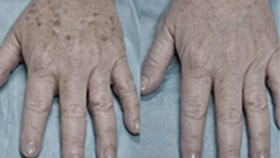There Is No Such Thing as a Safe Tanning Bed
Do not let a recent viral TikTok by Kim Kardashian persuade you! Tanning beds are harmful. I would even say that tanning beds are worse than natural sunlight. UV radiation is a proven, cancer-causing carcinogen and classified in the same category as cigarettes. The Skin Cancer Foundation reported that more than 419,000 cases of skin cancer in the United State. each year are associated with indoor tanning.
Natural sunlight emits both UVA and UVB light, while tanning beds emit UVA alone. Previously, it was thought that UVA just caused aging skin (sunspots, skin laxity, and wrinkles) and UVB light caused skin cancer. In Florida and beyond, we now know UVA causes aging skin and skin cancer. The UVA light penetrates deeper into the skin and is strongly linked to melanoma.
In addition, tanning beds emit 10 to 15 times more UVA light than the sun. There is no “safe dose” of this light, and even worse is that you have no idea how much light you are being exposed to, as the tanning bulbs can vary greatly. Even with short exposure people can get burns and blisters from tanning bed use.
Minors are especially at risk. Using tanning beds before age 20 can increase your chances of developing melanoma by 47 percent, and the risk increases the more you use the tanning bed. Thankfully, many states have banned minors from indoor tanning and hopefully more will get on the bandwagon soon. Countries such as Australia, Brazil, and Iran have recognized the dangers and have completely outlawed indoor tanning.
The top reason I have heard that people use a tanning bed: to get a base tan. This is a misnomer. Even if you have a “base tan,” you can still get a sunburn. This leads me to my next point. Many people think that it is only sunburns that are bad. Unfortunately, every time you tan OR burn, you damage the DNA in your skin. This damage accumulates and can lead to wrinkles, age spots, loss of skin firmness, and—worst of all—skin cancer. If you use tanning beds now or have used them in the past, I recommend having a dermatologist evaluate your skin. Contact us to arrange a visit.















